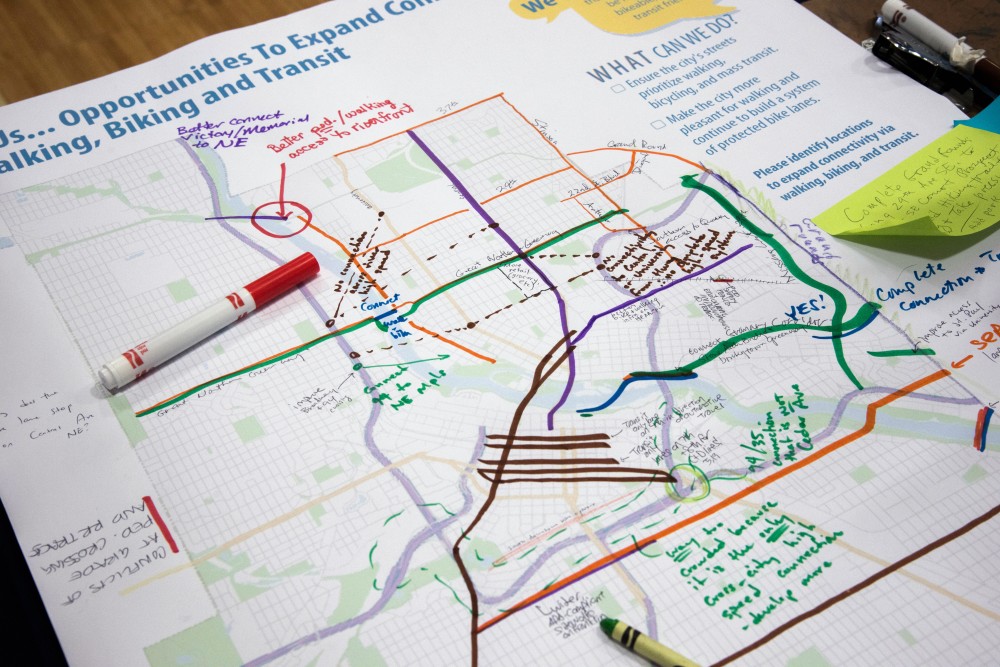Minneapolis city planners and local neighborhood organizations are developing long-term plans to shape the city’s future.
Several community engagement events mark the start of a new phase in the Minneapolis 2040 visioning process, which will influence the physical and economic development of the city in its 20-year comprehensive plan.
The first outreach event took place in Como’s Van Cleve Recreation Center on Saturday, Dec. 2, and featured discussion stations on transportation, housing and sustainability, among other themes. Each station allowed the public to indicate areas that needed change, make suggestions to the City and discuss ideas with city planners.
Wesley Durham, a city planner and recent University of Minnesota graduate, said Minneapolis 2040 draws much of its information from research teams, but thinks community outreach will help bring new insight to the planning staff.
“There is expertise that is not going to be garnered [by research] that we can get from public engagement events like this,” Durham said. “These questions of access to jobs and transportation and housing — what do they look like on the ground for people living those questions day-to-day?”

Flexibility in zoning and concerns over bike lanes and public transportation regularly came up on posters and post-it notes throughout the event. Comments regarding the Southeast Como and Marcy-Holmes neighborhoods indicated the need for more affordable living units.
“I think housing is going to be one of the biggest focuses of this document,” said Cody Olson, executive director of the Southeast Como Improvement Association. “In addition to that, transportation is another huge issue.”
Olson said his organization has been addressing some of these concerns at the local level through its long-term Como Blueprint, which seeks to maintain and improve “livability” in the area.
Housing and infrastructure have also been concerns for the Marcy-Holmes area.
Before the meeting, Bob Stableski, Marcy-Holmes Neighborhood Association President-elect, said historic preservation, infrastructure and maintaining a mix of housing were the current topics on his neighborhood’s mind.
“There’s been an issue here as it’s gotten more and more dense in Marcy-Holmes — we want to make sure infrastructure keeps up with that,” Stableski said. “Bus service, and lease protection and all of the policies that go into infrastructure.”

Similar to the Como Blueprint, Stableski and MHNA Executive Director Chris Lautenschlager established their own Marcy-Holmes’ master plan to set goals for housing, historic preservation and connectivity in the neighborhood. Many of the goals overlap with the Minneapolis 2040 plan.
Lautenschlager said the plan was the result of intense community engagement for over a year, and accurately reflects what many in the area want accomplished.
Erich Wunderlich, a Marcy-Holmes resident, expressed concerns over the area’s growing number of “luxury” housing units offered to students at Saturday’s event.
“We’ve got two classes of college students, the ones that can afford to live on campus in those units and the students that are struggling to get by,” Wunderlich said.
The event drew attendees from across Minneapolis, and included music, food and interactive “mobile engagement tools” by local artists Mike Hoyt and Molly Van Avery. Scrolls of art displayed past and present equity disparities in Minneapolis.
Few students attended the event.
“[Students] are a huge portion of the population, but it’s always hard to include them, engage them,” said Ted Tucker, a Marcy-Holmes resident and long-time Minneapolis Parks and Recreation Board volunteer.
By noon, roughly 100 community members had cycled through the gym and provided input to the city planners.
“People should be paying attention to this 2040 plan because what goes in there is going to determine what happens [in Minneapolis],” Stableski said.

















